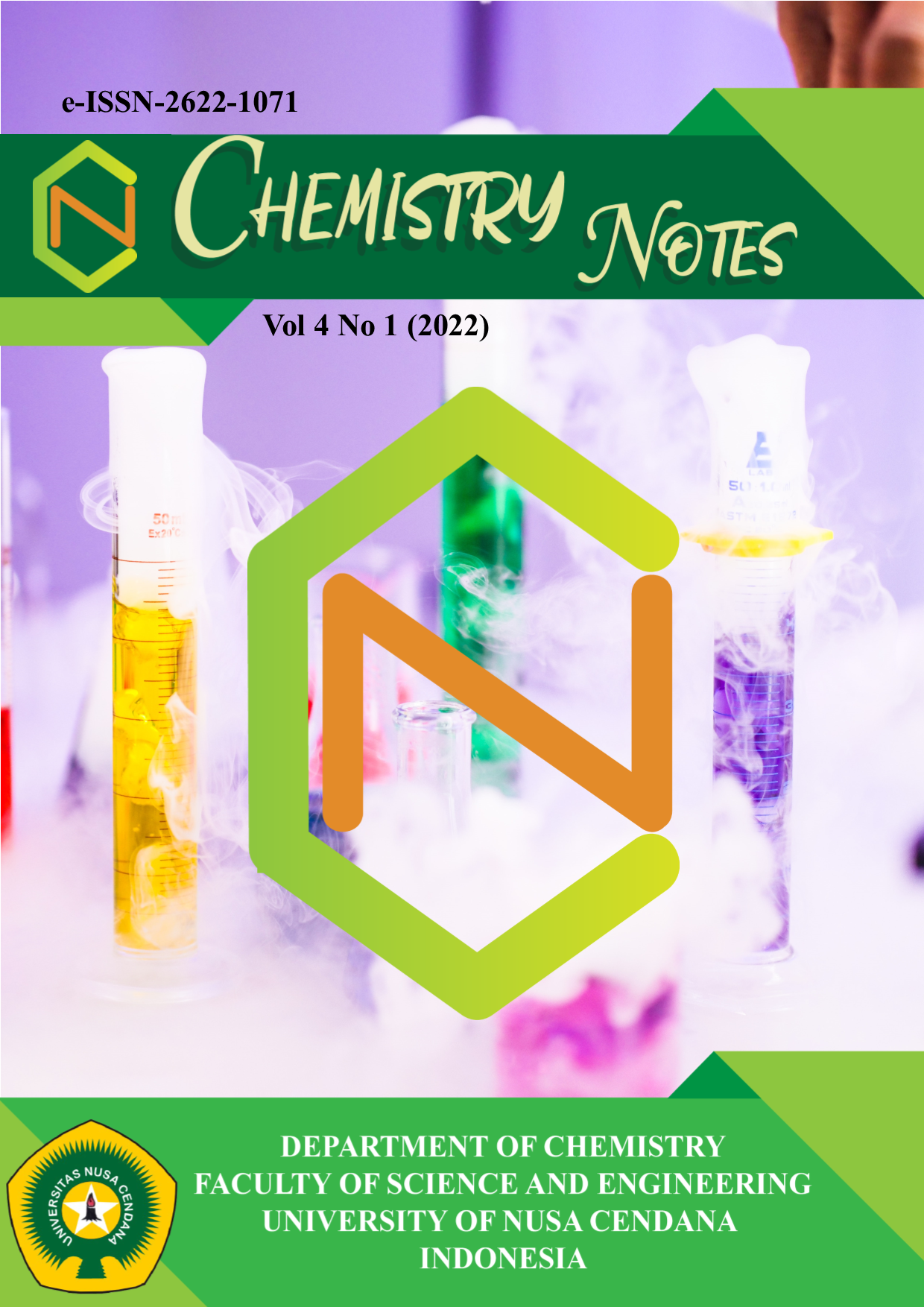Karakteristik Pelumas Bekas Hasil Adsorpsi Menggunakan Arang Batang Kesambi (Schleichera oleosa) dan Zeolit Alam Ende Teraktivasi H3PO4
Abstract
Used lubricants contain contaminants from oxidation and thermal degradation, resulting in a decrease in the quality and performance of the lubricant. Therefore, the adsorption process is carried out using kesambi stem charcoal and natural zeolite Ende activated H3PO4 to remove contaminants and improve the quality of used lubricants. Determination of the density and kinematic viscosity of used lubricants mass variations of 0.5, 0.66, 1 and 2 grams for each adsorbent. The results obtained show that the value of the used lubricant density from the adsorption results is relatively the same, namely 0.83 g/cm3, while the kinematic viscosity is different for each variation of the mass and type of adsorbent. Kesambi stem active charcoal has an optimum mass of 0.66 grams with a kinematic viscosity value of 128.84 cSt, active natural zeolite at a mass of 0.5 grams of 113.59 cSt and continued use of active natural zeolite-active natural charcoal, namely at a mass of 2 grams of 106, 38 cSt. These results indicate that the variation in the mass of the adsorbent has no effect on the change in density value but shows a significant change in the increase in the value of the kinematic viscosity of the used lubricant from the adsorption. The best percentage of kinematic viscosity increase efficiency is using activated charocoal, which is 71.83%.
Downloads
References
2. Boadu, K. O., Joel, O. F., Essumang, D. K. And Evbuomwan, B. O. 2019. A Review Of Methods For Removal Of Contaminants In Used Lubricating Oil. Chemical Science International Journal. 26(4) : 1-11.
3. Hajrah., Rusla., Prismawiryanti. 2018. Pemanfaatan Karbon Aktif Biji Kelor (Moringa oleifera) sebagai Penyerap Logam Timbal dalam Oli Bekas. Jurnal Riset Kimia, 4(3) : 297-303.
4. Siskayanti, R., Kosim, M. E.,Riawan, D. 2020. Efektifitas Arang Aktif dari Tempurung Kelapa dalam Mengadsorpsi Logam Fe pada Pelumas Motor Bekas Pakai. Jurnal Teknik Kimia, 5(2) : 108-115.
5. Sonjaya, A. N dan Rahmasari, F. 2019. Pengujian Pelumas Bekas SAE 15W-40 API CI-4. Jurnal Teknologi, 7(1) : 76-85.
6. Lathifah, T., Yuliani, N., Ayu, G. 2019. Bentonit Teraktivasi Asam Sulfat Sebagai Adsorben Dalam Pemurnian Pelumas Bekas. Jurnal Sains Natural. 9(1) : 1-10.
7. Kemala, D., Moersidik, S. S., Adityosulindro, S., Hilwa, F. 2019. Enhancing Lead Adsorpstion In Waste Lubricant Oil With Activated Clay As Bleaching Earth. MATEC Web Of Conferences 276 : 1-7.
8. Prasaji, R., Dewita, C. U., Santosa, H. 2013. Pemanfaatan Kombinasi Fly Ash Batubara, Alkilbenzene Sulfonat dan Zeolit pada Penjernihan Minyak Pelumas Bekas dengan Metode Penjerapan. Jurnal Teknologi Kimia dan Industri, 2(4) : 1-7.
9. Nugrahaningtyas, K. D dan Widjonarko, D. M. 2016. Kajian Aktivasi H2SO4 Terhadap Proses Pemilaran Al2O3 Pada Lempung Alam Pacitan. Jurnal Penelitian Kimia, 12(2) : 190-203.
10. Widihati, I. A. G., Ratnayani, O dan Angelina, Y. 2010. Karakterisasi Keasaman dan Luas Permukaan Tempurung Kelapa Hijau (Cocos nucifera) dan Pemanfaatannya sebagai Biosorben Ion Cd2+. Jurnal Kimia, 4 (1) : 7-14.
11. Damayanti, N. A., Selintung, M., Zubair, A. 2016. Perbandingan Efektivitas Arang Tempurung Kelapa dan Zeolit Alam Teraktivasi dalam Penjernihan Minyak Goreng Bekas.
12. Salem, S., Salem, A., Babaei, A. A. 2014. Application of Iranian Nano-Porous Ca-Bentonite for Recovery of Waste Lubricant Oil by Distillation and Adsorption Techniques. Journal of Industrial and Engineering Chemistry. 1-9.
13. Udonne, J. D., Efeovbokhan, V. E., Ayoola, A. A., Babatude, D. E., Ifeoluwa, A and Ajalo, I. J. 2016. Recycling Used Lubricating Oil Using Untreated, Activated and Calcined Clay Methods. Journal Of Engineering and Applied Sciences, 11(6) : 1396-1401.
14. Rahmadhaniar. A., Nugrahani, R.A., Fithriyah, N. H., Lestariningsih, T. 2020. Lead Adsorption in Lubricant Waste Using Zeolite. Jurnal Rekayasa Proses, 14(1) : 1-7.
15. Mara, I. M., Kurniawan, A. 2015. Analisa Pemurnian Minyak Pelumas Bekas Dengan Metode Acid And Clay. Jurnal Dinamika Teknik Mesin, 5(2) : 106-112.
16. Muttaqi, M. A., Birawidha, D. C., Isnugroho, K., Amin, M., Hendronursito, Y., Istiqomah, A. D., Dewangga, D. P. 2019. Pengaruh Aktivasi Secara Kimia Menggunakan Larutan Asam dan Basa Terhadap Karakteristik Zeolit Alam. Jurnal Riset Teknologi Industri, 13(2) : 266-271.
In order to publish in Chemistry Notes, authors are required to agree to the copyright permission stating that the authors give the publisher the right to reproduce, display or distribute the accepted manuscript. In this agreement the authors also automatically declare that the submitted manuscript is exempted from plagiarism issue and conflict of interest among the authors.

 Theodorus M. Da Cunha(1*)
Theodorus M. Da Cunha(1*)





